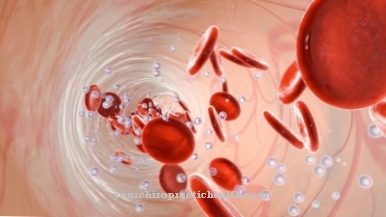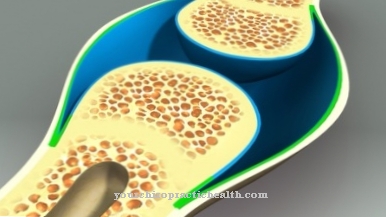The term Short feedback mechanism comes from endocrinology. It describes a control loop in which a hormone can directly inhibit its own effect.
What is the short feedback mechanism?

The short feedback mechanism is one of the control loops. Control loops regulate many different body functions. The short feedback mechanisms are mainly found in the area of hormones. As part of this mechanism, a hormone can inhibit its own secretion.
This process is usually based on an autocrine effect. In the autocrine secretion mode, the gland cells release their hormone products directly into the surrounding interstitium. The autocrine secretion is basically a special case of the paracrine hormone secretion. Paracrine glands release their secretion into the immediate environment, but they do not influence themselves.
Examples of short feedback mechanisms are the Brokken-Wiersinga-Prummel control loop or mechanisms in the secretion of LH and FSH. Like many cytokines and tissue hormones, insulin also has an autocrine effect.
Function & task
Short feedback mechanisms are independent, very small control loops. However, they usually complement larger control loops. An example of such a supplementary control loop is the short feedback mechanism of the thyroid stimulating hormone (TSH). TSH is a hormone made in the pituitary gland. It reaches the TSH receptors on the thyroid gland via the bloodstream and binds there. TSH stimulates the growth of the thyroid gland and the secretion of the thyroid hormones triiodothyronine (T3) and thyroxine (T4).
The pituitary gland constantly measures the level of thyroid hormones in the blood and uses it to regulate its own hormone release. Therefore, when there is a lot of thyroid hormones in the blood, it produces less FSH. If, on the other hand, the pituitary gland measures a deficiency in thyroid hormones, it produces more FSH to stimulate the thyroid gland to produce. This control loop is also known as a thyrotropic control loop.
In addition, there is a long feedback mechanism and a short feedback mechanism. The latter is a short feedback from the TSH level on its own distribution. To do this, the TSH, which is produced in the pituitary gland, binds to so-called thyrotropin receptors. These are located directly in the anterior pituitary gland, i.e. exactly at the place where the TSH is also formed. When TSH attaches to these folliculostellar cells, they presumably secrete thyroid stimulin.
This inhibits secretion from the thyroid cells of the pituitary gland. The aim of the short feedback mechanism is presumably to prevent the pituitary gland from producing excessive TSH. In addition, this short feedback also enables a pulsatile release of TSH.
Further physiological short feedback mechanisms can be found in the secretion of LH and FSH. LH is the luteinizing hormone. Together with FSH, the follicle-stimulating hormone, it is responsible for the production and maturation of a woman's sex cells. Both LH and FSH are produced in the pituitary gland (pituitary gland).
Other hormones of the hypothalamus, such as galanin and the gonadotropin releasing hormone, are also regulated by short feedback. In principle, any short feedback mechanism in the body can be impaired. This often leads to disorders within the hormonal balance.
Illnesses & ailments
A well-known example of a disorder of the short feedback mechanism is Graves' disease. Graves' disease is an autoimmune disease that predominantly affects the thyroid. Around two to three percent of all women in Germany suffer from Graves' disease. Men are extremely rarely affected. The maximum illness is between the ages of 20 and 40.
The causes of the disease are complex. On the one hand, a genetic defect was found in those affected. This presumably leads to a disturbance of the immune system. However, various influences can increase the risk of the disease. These include, for example, smoking or viral infections. An outbreak of the disease is often observed after psychologically stressful events.
The body makes antibodies against the tissues of the thyroid gland. The antibodies are called TSH receptor antibodies (TRAK). They are found in more than 90% of the sick. These bind to the organ's TSH receptors. TSH normally docks here and animates the thyroid gland to produce thyroid hormones. However, the receptor is now permanently occupied by antibodies. These have the same effect as the TSH. This leads to an overactive thyroid. Normally, the short feedback mechanism in the pituitary gland should protect against hyperfunction. But the thyroid gland is isolated from the control loop by the attack of the antibodies. It produces hormones regardless of the TSH level in the blood. The pituitary gland then secretes almost no TSH.
Nevertheless, the short feedback mechanism still plays a decisive role in Graves' disease. During follow-up checks, the doctor often determines the TSH level alone. However, this is often not enough, because the antibodies can not only bind to the thyroid receptors, but also to the TSH receptors, which are located directly on the pituitary gland. There they inhibit the release of TSH. So it could be that the thyroid is not overactive and the TSH value is still low.
mg src = "https://vg03.met.vgwort.de/na/8dced1d7a9a84d9395db53a5b92aa501" width = "1" height = "1" alt = "">



























